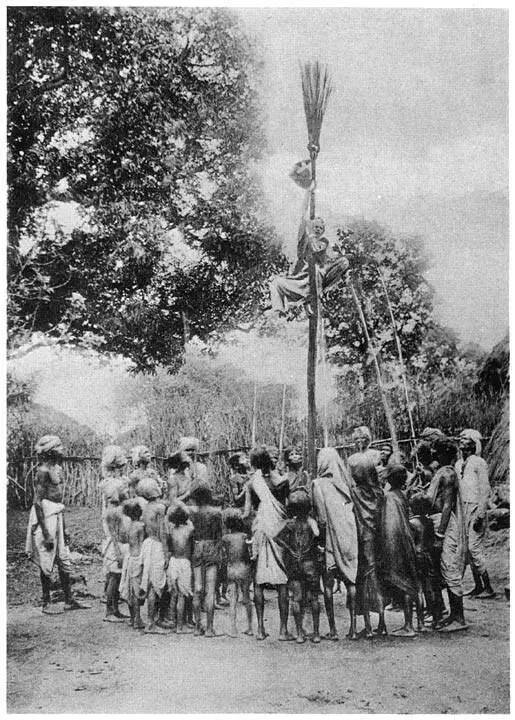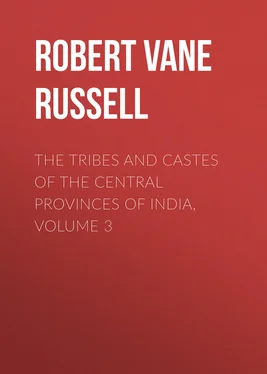Robert Vane Russell - The Tribes and Castes of the Central Provinces of India, Volume 3
Здесь есть возможность читать онлайн «Robert Vane Russell - The Tribes and Castes of the Central Provinces of India, Volume 3» — ознакомительный отрывок электронной книги совершенно бесплатно, а после прочтения отрывка купить полную версию. В некоторых случаях можно слушать аудио, скачать через торрент в формате fb2 и присутствует краткое содержание. Жанр: foreign_prose, История, foreign_edu, foreign_antique, на английском языке. Описание произведения, (предисловие) а так же отзывы посетителей доступны на портале библиотеки ЛибКат.
- Название:The Tribes and Castes of the Central Provinces of India, Volume 3
- Автор:
- Жанр:
- Год:неизвестен
- ISBN:нет данных
- Рейтинг книги:5 / 5. Голосов: 1
-
Избранное:Добавить в избранное
- Отзывы:
-
Ваша оценка:
- 100
- 1
- 2
- 3
- 4
- 5
The Tribes and Castes of the Central Provinces of India, Volume 3: краткое содержание, описание и аннотация
Предлагаем к чтению аннотацию, описание, краткое содержание или предисловие (зависит от того, что написал сам автор книги «The Tribes and Castes of the Central Provinces of India, Volume 3»). Если вы не нашли необходимую информацию о книге — напишите в комментариях, мы постараемся отыскать её.
The Tribes and Castes of the Central Provinces of India, Volume 3 — читать онлайн ознакомительный отрывок
Ниже представлен текст книги, разбитый по страницам. Система сохранения места последней прочитанной страницы, позволяет с удобством читать онлайн бесплатно книгу «The Tribes and Castes of the Central Provinces of India, Volume 3», без необходимости каждый раз заново искать на чём Вы остановились. Поставьте закладку, и сможете в любой момент перейти на страницу, на которой закончили чтение.
Интервал:
Закладка:

Climbing the pole for a bag of sugar
In Kunwār (September) the Gond girls take an earthen pot, pierce it with holes, and put a lamp inside and also the image of a dove, and go round from house to house singing and dancing, led by a girl carrying the pot on her head. They collect contributions and have a feast. In Chhattīsgarh among the Gonds and Rāwats (Ahīrs) there is from time to time a kind of feminist movement, which is called the Stiria-Rāj or kingdom of women. The women pretend to be soldiers, seize all the weapons, axes and spears that they can get hold of, and march in a body from village to village. At each village they kill a goat and send its head to another village, and then the women of that village come and join them. During this time they leave their hair unbound and think that they are establishing the kingdom of women. After some months the movement subsides, and it is said to occur at irregular intervals with a number of years between each. The women are commonly considered to be out of their senses.
(g) Appearance and Character, and Social Rules and Customs
57. Physical type
Hislop describes the Gonds as follows: 81 81 Notes , p. 1.
“All are a little below the average size of Europeans and in complexion darker than the generality of Hindus. Their bodies are well proportioned, but their features rather ugly. They have a roundish head, distended nostrils, wide mouth, thickish lips, straight black hair and scanty beard and moustache. It has been supposed that some of the aborigines of Central India have woolly hair; but this is a mistake. Among the thousands I have seen I have not found one with hair like a negro.” Captain Forsyth says: 82 82 Highlands of Central India , p. 156.
“The Gond women differ among themselves more than the men. They are somewhat lighter in colour and less fleshy than Korku women. But the Gond women of different parts of the country vary greatly in appearance, many of them in the open tracts being great robust creatures, finer animals by far than the men; and here Hindu blood may fairly be expected. In the interior again bevies of Gond women may be seen who are more like monkeys than human beings. The features of all are strongly marked and coarse. The girls occasionally possess such comeliness as attaches to general plumpness and a good-humoured expression of face; but when their short youth is over all pass at once into a hideous age. Their hard lives, sharing as they do all the labours of the men except that of hunting, suffice to account for this.” There is not the least doubt that the Gonds of the more open and civilised country, comprised in British Districts, have a large admixture of Hindu blood. They commonly work as farmservants, women as well as men, and illicit connections with their Hindu masters have been a natural result. This interbreeding, as well as the better quality of food which those who have taken to regular cultivation obtain, have perhaps conduced to improve the Gond physical type. Gond men as tall as Hindus, and more strongly built and with comparatively well-cut features, are now frequently seen, though the broad flat nose is still characteristic of the tribe as a whole. Most Gonds have very little hair on the face.
58. Character
Of the Māria Gonds, Colonel Glasfurd wrote 83 83 Report on Bastar Dependency , p. 41.
that “They are a timid, quiet race, docile, and though addicted to drinking they are not quarrelsome. Without exception they are the most cheerful, light-hearted people I have met with, always laughing and joking among themselves. Seldom does a Māria village resound with quarrels or wrangling among either sex, and in this respect they present a marked contrast to those in more civilised tracts. They, in common with many other wild races, bear a singular character for truthfulness and honesty, and when once they get over the feeling of shyness which is natural to them, are exceedingly frank and communicative.” Writing in 1825 Sleeman said: “Such is the simplicity and honesty of character of the wildest of these Gonds that when they have agreed to a jama 84 84 Assessment of revenue for land.
they will pay it, though they sell their children to do so, and will also pay it at the precise time that they agreed to. They are dishonest only in direct theft, and few of them will refuse to take another man’s property when a fair occasion offers, but they will immediately acknowledge it.” 85 85 Quoted in C.P. Gazetteer (1871), Introduction, p. 113.
The more civilised Gonds retain these characteristics to a large extent, though contact with the Hindus and the increased complexity of life have rendered them less guileless. Murder is a comparatively frequent crime among Gonds, and is usually due either to some quarrel about a woman or to a drunken affray. The kidnapping of girls for marriage is also common, though hardly reckoned as an offence by the Gonds themselves. Otherwise crime is extremely rare in Gond villages as a rule. As farmservants the Gonds are esteemed fairly honest and hard-working; but unless well driven they are constitutionally averse to labour, and care nothing about provision for the future. The proverb says, ‘The Gond considers himself a king as long as he has a pot of grain in the house,’ meaning that while he has food for a day or two he will not work for any more. During the hot weather the Gonds go about in parties and pay visits to their relatives, staying with them several days, and the time is spent simply in eating, drinking when liquor is available, and conversation. The visitors take presents of grain and pulse with them and these go to augment the host’s resources. The latter will kill a chicken or, as a great treat, a young pig. Mr. Montgomerie writes of the Gonds as follows: 86 86 Chhīndwāra Settlement Report.
“They are a pleasant people, and leave kindly memories in those who have to do with them. Comparatively truthful, always ready for a laugh, familiar with the paths and animals and fruits of the forest, lazy cultivators on their own account but good farmservants under supervision, the broad-nosed Gonds are the fit inhabitants of the hilly and jungly tracts in which they are found. With a marigold tucked into his hair above his left ear, with an axe in his hand and a grin on his face, the Gond turns out cheerfully to beat for game, and at the end of the day spends his beating pay on liquor for himself or on sweetmeats for his children. He may, in the previous year, have been subsisting largely on jungle fruits and roots because his harvest failed, but he does not dream of investing his modest beating pay in grain.”
59. Shyness and ignorance
In the wilder tracts the Gonds were, until recently, extremely shy of strangers, and would fly at their approach. Their tribute to the Rāja of Bastar, paid in kind, was collected once a year by an officer who beat a tom-tom outside the village and forthwith hid himself, whereupon the inhabitants brought out whatever they had to give and deposited it on an appointed spot. Colonel Glasfurd notes that they had great fear of a horse, and the sight of a man on horseback would put a whole village to flight. 87 87 Report on Bastar Dependency , p. 43.
Even within the writer’s experience, in the wilder forest tracts of Chānda Gond women picking up mahua would run and climb a tree at one’s approach on a pony. As displaying the ignorance of the Gonds, Mr. Cain relates 88 88 Ind. Ant. (1876), p. 359.
that about forty years ago a Gond was sent with a basket of mangoes from Palvatsa to Bhadrachalam, and was warned not to eat any of the fruit, as it would be known if he did so from a note placed in the basket. On the way, however, the Gond and his companion were overcome by the attraction of the fruit, and decided that if they buried the note it would be unable to see them eating. They accordingly did so and ate some of the mangoes, and when taxed with their dishonesty at the journey’s end, could not understand how the note could have known of their eating the mangoes when it had not seen them.
Интервал:
Закладка:
Похожие книги на «The Tribes and Castes of the Central Provinces of India, Volume 3»
Представляем Вашему вниманию похожие книги на «The Tribes and Castes of the Central Provinces of India, Volume 3» списком для выбора. Мы отобрали схожую по названию и смыслу литературу в надежде предоставить читателям больше вариантов отыскать новые, интересные, ещё непрочитанные произведения.
Обсуждение, отзывы о книге «The Tribes and Castes of the Central Provinces of India, Volume 3» и просто собственные мнения читателей. Оставьте ваши комментарии, напишите, что Вы думаете о произведении, его смысле или главных героях. Укажите что конкретно понравилось, а что нет, и почему Вы так считаете.












